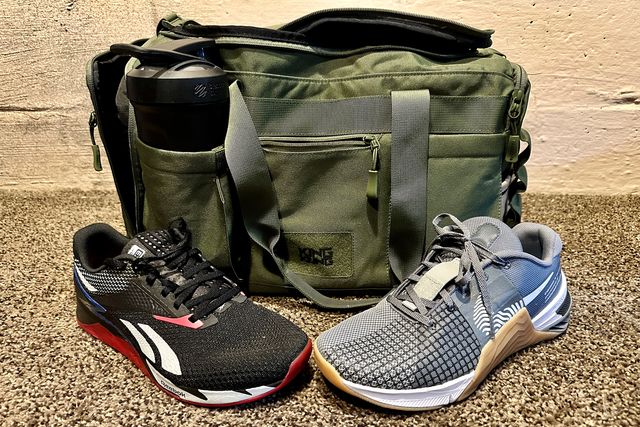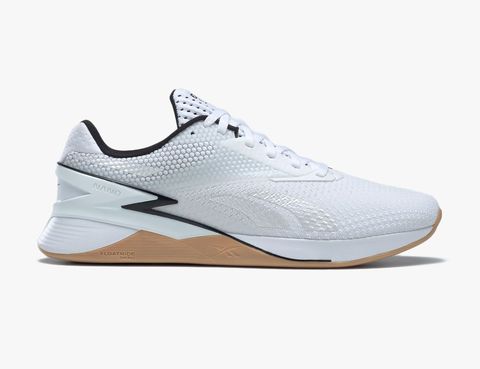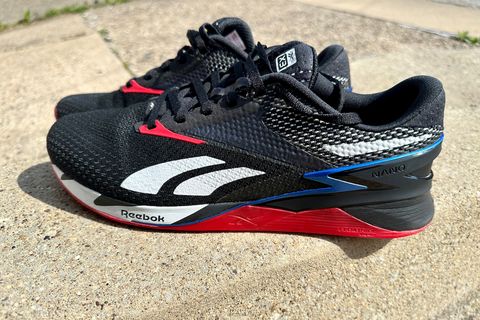When you think of the fitness realm, there's a number of brands synonymous with the category. In terms of training-specific footwear, both Reebok and Nike have longstanding presences in the field, delivering timeless shoes offering up plenty of performance and support, regardless of your workout discipline.
For in-gym work, for example, Reebok's Nano and Nike's Metcon stables have continuously gone head-to-head vying for dominance. Now, the battle rages on with the latest iterations: the Nano X3 and Metcon 8.
Comparing and contrasting gym shoes is sort of my thing, so to see which sneaker slid into the pole position this year, I donned each silhouette for multiple weeks across a number of training disciplines. From free weight lifts like squats and deadlifts to CrossFit-centric movements and plyometrics, varying running routes and more, I put both the Metcon 8s and Nano X3s to the test to see which brand delivered the goods. Outside of training performance, I also noted other key qualities like durability, comfort and (of course) style.
Here's how this rendition of the Reebok vs. Nike debate shakes out in regards to the latest designs on the market.
The Contenders for Best Gym Shoe
Nike Metcon 8
The latest Metcon silhouette doesn’t reinvent the wheel when it comes to built-in tech, but does make key upgrades over its predecessor in terms of design and build quality. A reworked upper showcases textured overlays, providing a heightened sense of durability when pacing through plyometrics or other, more dynamic movements. Additionally, while the Metcon 8 forgoes a medial rope guard, this profile is still plenty capable of getting you off the ground and toward the ceiling without slippage or compromised grip.
While some might want a little more out of this revamped iteration, it is nice to see Nike sticking with tried and true components, most notably the Nike React foam midsole. This feature has been a stalwart in various training scenarios, providing excellent comfort and responsiveness whether training with weights or running through sprint sessions or agility drills. Like other Metcons of yesteryear, though, that responsiveness is best kept for short bursts or more static movements; any long-distance running is asking too much of these otherwise impressive kicks.
Reebok Nano X3
“New and improved” is sort of an understatement when it comes to the Nano X3. Thanks to a reworked FlexWeave upper and innovative Lift and Run Chassis System, this latest iteration is quite different from previous profiles. For one, the upper has a more rigid feel to it that doesn’t stretch as much over extended use. This helps create a more secure setup that can keep your feet contained whether just starting a program or wrapping up a routine.
In terms of the Lift and Run Chassis System, this all-new component sits comfortably in the midsole and pairs to a dome TPU unit in the heel that changes rigidity depending on your load. Getting under a barbell squat? The TPU hardens to promote a static, stable base. Getting some miles in on the treadmill? Expect to feel a heightened sense of comfort as the unit softens for a responsive yet cushioned ride.
How to Choose Which Gym Shoe is Right for You
Like any activity-specific footwear, gym shoes require a few basic features to help accentuate your training performance. For one, your workout sneakers should feature less cushioning than, say, your go-to pair of running shoes. While it might seem like this will create a less comfortable setup, the lack of cushioning in the heel and midsole has a purpose. During a lift, you want to create as stable a base as possible with plenty of balance, and if you're trying to ground your stance through mountains of plush foam, you're less likely to achieve that aesthetic. This is why most trainers employ a more rigid setup that delivers some comfort without sacrificing that stable nature.
Speaking of getting grounded, most gym shoes feature a shorter heel-to-toe drop. This component places your heel closer to the ground, allowing you to better push or brace in the throws of a lift. A typical drop range for gym shoes is 0–4mm, but some can set the heel higher for added comfort. Additionally, a higher heel-to-toe drop can be desired for certain exercises, particularly squats and Olympic lifts, as it places the foot at a more aggressive angle and places the stress of the weight across varied muscle groups for more efficient training.
In terms of outsoles, most gym shoes feature a multi-directional tread pattern to help enhance grip and traction across varied movements. This varied pattern can aide in keeping you upright, especially when performing dynamic plyometrics or other agility drills, similar to the functionality you'd find in top-performing basketball shoes. Plus, it's common to find gym shoes with a flatter outsole construction, harkening back to the desired ground contact you want for most heavy lifts.
Finally, your gym shoes are likely to go through more abuse than your daily sneakers, so it's always smart to look for profiles boasting a more durable upper construction. Rigid mesh and tightly-woven weaves are standard within this subcategory, as these makeups can help extend a shoe's lifespan while still allowing it to be breathable — no need to lock in all that perspiration if it can be avoided.
Test 1: Stability and Support
In testing, I was thoroughly pleased with the level of stability found in both the Metcon 8s and Nano X3s. In the Nikes, the React Foam midsole provided that perfect blend of rigidity and coziness that’s made it a go-to for many athletes throughout the years. In the case for Reebok, I enjoyed the rigidity displayed across the new chassis system, and the Floatride Energy foam gave a nice blend of cushioning without creating too much plush.
I give this test to the Metcons, though, because of the lower heel-to-toe drop. While I did appreciate the taller 7mm drop in the Nano X3s, particularly during squat sessions, I felt the lower heel of the Metcons was more versatile across a number of lifts and workouts. This isn’t to say the Lift and Run Chassis System doesn’t work — you can still achieve that rigid base in a number of lifts, including deadlifts — but for my taste and lifting style, I prefer that more grounded approach displayed in the Nike offering.
Test 2: Cardio-Based Performance
I preface this testing section by saying neither the Metcon 8s or Nano X3s should be viewed as replacements for your typical running shoes. As stated earlier, shoes designed for in-gym training feature less cushioning than dedicated running sneakers and are more rigid by nature. With that said, however, there are occasions where you need to be multi-faceted in your training, especially when working through a WOD or HIIT session that calls for some sprints or longer jogs.
Across multiple sessions and routes, I found these minor running scenarios far more enjoyable when laced up in the Nano X3s. The all-new chassis system provides a far superior ride to that of the Metcons; this is where you truly experience the all-new tech at its fullest. There’s no hard underfoot feel thanks to the softened TPU unit, and the higher heel-to-toe drop is better suited for that forward roll you see in your running stride. I wouldn’t say it’s a super-comfy ride built for long distances, but when compared to the more rigid Nikes, it’s leaps and bounds ahead of the competition. If you typically add in sprint sessions or cooldown jogs to your regimen, consider the Nano X3s as a solid one-stop solution.
Test 3: Fit and Comfort
In terms of comfort, I feel both the Nike Metcon 8s and Reebok Nano X3s are cozy enough to keep you on your feet for extended training sessions — which was a definite plus when my schedule called for multi-hour workouts surrounded by plates and machines. There are some quirks, though, that are worth noting across the two profiles.
In terms of breathability, I felt my feet stayed cooler and cozier with the Nano X3s, which I attribute to the textured overlays of the Metcons that did little to help dissipate that pooling perspiration in the footbed. When it comes to a locked-in fit, I felt the Metcons shined in this regard, as I experienced some slight heel slippage in the Reeboks. Thankfully, though, the Nano X3s do offer an extra eyelet that allows for a lace lock setup — provided you know how to tie one in.
While the two callouts are worth noting, there are enough work-arounds to eliminate them from future training endeavors. It’s best to let this as a toss up to personal preference and call it a tie.
Best Overall Gym Shoe: Nike Metcon 8
In my opinion, this is the closest the Nike vs. Reebok debate has been in some time. Each profile has a valid argument for its dominance across gym floors and training centers, but in my opinion, the title of “best gym shoe” is still held by the Metcon lineup. I appreciate the lower heel-to-toe drop that’s more ideal for the average athlete’s needs, and the lockdown fit is right from the start without the need for more advanced lacing setups.
While those wanting more cardio out of their training shoes may want to look elsewhere — Nike still has you covered with everything from max-cushioned runners to race-ready silhouettes — this is still one of my favorite profiles to pop on for hard-nosed training sessions.
Get the Nike Metcon 8 Here
SHOP NOW (DICK'S SPORTING GOODS) | SHOP NOW (ROAD RUNNER SPORTS) | SHOP NOW (NORDSTROM)
Best Gym Shoe for Dynamic Training: Reebok Nano X3
Don’t think the Reebok Nano X3s don’t have their place in training get-ups. When it comes to more varied training days, or sessions where CrossFit is the name of the game, I thoroughly prefer the latest Reebok iteration over any other competing silhouette. The Lift and Run Chassis System is perfect for these multi-faceted needs, and I appreciate how seamless it is to transition from lifting scenarios to more agility or cardio-focused exercise. Plus, the comfort and durability exhibited in the FlexWeave upper ensures your kicks are ready for the long haul.
If you’re often more specialized in your circuits or need a shoe that’s capable of performing multiple disciplines across its lifespan, definitely consider the Nano X3s as your next pair of fitness-oriented footwear.
Get the Reebok Nano X3 Here
SHOP NOW (REEBOK) | SHOP NOW (ROAD RUNNER SPORTS) | SHOP NOW (AMAZON)




























